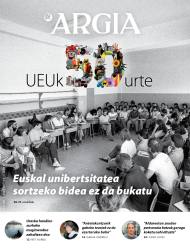Strategy and tools
Metal workers strike. Bilbao Metro. Residences of Gipuzkoa. The three examples are the most obvious strikes that have been launched in the last month, highlighting the willingness of staff to improve their working conditions. Faced with them, the employers and the public administration, who denounce the violence and intransigence of the workers, want to silence the class conflict.
Émile Pouget clearly defined the main fighting methods of the working class: strike, boycott and sabotage. These are examples of direct action that powers have wanted to relate to violence. Sabotage is highly criminalised and the administration has tried to dismantle the boycott legally. By way of example, in 2014 the Basque Competition Authority imposed a fine of EUR 800,000 on carriers of the port of Bilbao for the promotion of the boycott. The High Court of Justice of the Basque Country suspended the fine, but at a time of conflict, the shock affecting promoters and participants may paralyse the action. The right to strike is also very limited. In the case of Spanish legislation, rotating strikes, liability strikes, which are carried out in strategic sectors, among others, are illegal. Strikes are illegal for political, solidarity and other reasons. To this should be added the use of minimum services by public administrations to break strikes.
"The endurance box is not a magic remedy, but it can be an essential element to cope with the deterioration of working conditions. Also to maintain employment
Despite the obstacles, strikes occur in our territory: In 2021, 47% of the strikes in the Kingdom of Spain occurred in the peninsular Basque Country. How can we explain the exercise of such a limited right? Strike strategies are fundamental, as Las Heras and Rodríguez discussed in a 2020 article (Striking to renew: Basque Unions’ organizing strategies and use of the Strike Fund). The authors pointed out, among other factors, that the counter-union model is an important factor that places conflict at the centre of innovation strategies and that it can be representative of the number of strikes. This organizational strategy does not want to mobilize workers to “create an illusion of strength”, but to achieve a mobilization that moves towards a more cohesive and dynamic union model. In this competitive strategy, the resistance fund is a decisive resource of organizational power that gathers from the purchasing power of union members to help the militant members most in need.
Thus, the trade unions that follow the counterpart model have the resistance boxes in force or are under discussion for their implementation. Companies use strategies to avoid any kind of responsibility to workers and, in a violent process of precariousness of working conditions, it is essential to have as many tools as possible; the resistance box can be fundamental to resolve conflicts in favor of workers. Even more so in a context where the cost of living is rising and the endless crisis we are experiencing is hardening.
The endurance box is not a magic remedy, but it can be an essential element to cope with the deterioration of working conditions. Also to maintain employment, and why not, to extend quality employment. These issues are excluded from conventional economic analysis, but they contribute a great deal to the welfare of society, as most of us are workers.
Bidali zure iritzi artikuluak iritzia@argia.eus helbide elektronikora
ARGIAk ez du zertan bat etorri artikuluen edukiarekin. Idatzien gehienezko luzera 4.500 karakterekoa da (espazioak barne). Idazkera aldetik gutxieneko zuzentasun bat beharrezkoa da: batetik, ARGIAk ezin du hartu zuzenketa sakona egiteko lanik; bestetik, egitekotan edukia nahi gabe aldatzeko arriskua dago. ARGIAk azaleko zuzenketak edo moldaketak egingo dizkie artikuluei, behar izanez gero.
These were my last words when we left, held hand in your deep breathing sleep. Your heart stayed forever without a special, simple, dignified pain. As you want and demand. How we want and respect.
Already a month before the arrival of winter, the last days of the longest night,... [+]
Today, the voices of women and children remain within a culture that delegitimizes their voices, silencing their experiences, within a system aimed at minimizing or ignoring their basic rights and needs. A media example of this problem is the case of Juana Rivas, but her story... [+]
On Tuesday, the sentence was released against five young people from Lapurdi, convicted of belonging to Segi. Fifteen months in prison for reversal to two young people, with a fine of EUR 500 each; 140 hours of forced labour and EUR 500 fine to two other young people; and,... [+]
The other day, as I was walking through the famous television series The Wire, there came a scene that reminded me of despair. There, the management of the newspaper The Baltimore Sun brought together the workers and alerted them to the changes that are coming, i.e. redundancies... [+]
The consumerist culture we live in sends every user to an unreasonable enjoyment. As Slavoj Zize says, Enjoy your fetish, it has become the rude mandate of hypermodernity. Current enjoyment is carried out through existing technological devices to occupy the place of fetish. But... [+]
A ghost crosses the kitchens: The ghosts of Carlos.
Karlos has not been presented to the Master Chef Celebrity. After analyzing its culinary heritage, it is very clear that it will not overcome the selection of its opponents. In fact, the Academy of Gastronomy and the media... [+]
In 2018, I leveraged social media and most communications from devices to try to control where I focus on life. Every day I go on that task, in the light of the moth, because my curiosity is constantly looking for fresh information to help me understand reality. At that time I... [+]
Beyoncé at the break of an American football game in Houston, Texas. The American singer has come to the center of the stadium in a cowboy suit that she's had access to. The hat covers the nice, the legs the boots long to the knees. The scarce white suit shows her thighs and... [+]
The new Syrian president has withdrawn his hand to the chest of the German Foreign Minister, the minister, and denied him the handshake. Politely, Annalena Baerbock suffers contempt. Before that, the Syrian Al-Golani has reached out to the French Foreign Minister, Jean-Noel... [+]
The New Year’s Morning is the title of a roundness created by Joxe Ansorena, brother of our grandfather Isidro, for the Txistularis to hit the streets during the New Year’s Morning. In the air of that melody, we were picking up the wrecks of the night, like the garbage... [+]
We were yelling, “New Year, what brings us?”, around the first night of the year, at the preemies who crossed the road. Waiting for the foals, drunks, us. And as there was no runner or selfie yet, we would find most of the Russians who had gone out to put down the excesses... [+]
Donald Trump will take office again on January 20 and will resume office as President of the United States. If, in the previous mandate, 2017-2021, he was not shameful in decision-making, in this mandate he will remove those scarce complexes and do whatever he wants, as the... [+]
The achievement of the Euskadi Selection has undoubtedly been a historic achievement. But if you stick to that, for many Basques – I too, because I am Navarro – it will be the darkest and saddest day. After enjoying the joy and warmth of the first few days, let's go back to... [+]
Hearing and language teachers (PDI) and speech therapists are specialist teachers who work in both the public and the concerted school. Among its functions is the direct attention to students with language and communication difficulties, but also the establishment of incremental... [+]











.jpg)







